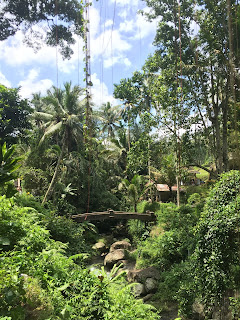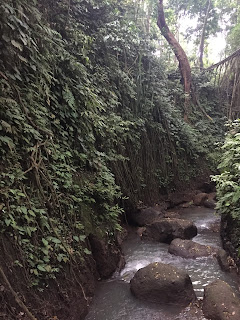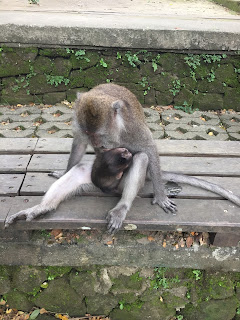We woke up to this amazing view from the kitchen. I can't believe we are getting to have this adventure and experience together! It seems like a dream.
This is the front yard view from the house. Similar to Singapore, everything is so green and tropical.
We read that it is easiest to hire a driver for the day in Ubud since the temples and sites we'd like to visit are not walking distance from each other. They drive on the left side of the road here, and there are lots of scooters. Many scooters have 3-4 people riding on them, and it was not unusual to see a kid standing or siting in front or between parents.
Our driver, Nick, was a local Balinese man from Ubud. He had grown up in a neighboring village, and got involved in the tourism industry though the Australia family that built the house we are renting. He was so kind and told us lots of history and information about the temples and places he recommended we visit (many of which were on the list we had made together). Our first stop was Gunung Kawi. Gunung Kawi is an 11th-century temple and funerary complex in Tampksiring north east of Ubud in Bali, Indonesia, that is spread across either side of the Pakerisan river. It comprises 10 rock-cut candi (shrines) that are carved into 23 foot sheltered niches of the sheer cliff face. These funeral monuments are thought to be dedicated to King Anak Wungsu of the Udayana dynasty and his favorite queens. On the north shrine (east side) a legible inscription reads "Haji Lumahing Jalu" meaning "the king made a temple here." In the temples, men and women were required to wear a sarong to cover their legs when wearing shorts. To reach the temple we went down over 300 steps into the valley and the views were incredible!











All over Bali we these beautiful offerings:
It is called "canang sari" and it is one of the daily offerings made by Balinese Hindus to thank Sang Hyang Widhi Wasa in praise and prayer. Canang sari is seen in the Balinese temples, on small shrines in houses, and on the ground. The phrase canang sari is derived from the Balinese words sari (essence) and canang (a small palm-leaf basket as the tray). Canang itself consists of two syllables from the Kawi language: ca (beautiful) and nang (purpose). Canang sari is offered every day as a form of thanking for the peace given to the world. The philosophy behind the offering is self-sacrifice in that they take time and effort to prepare. Needless to say, I love this idea, symbolism, and meaning.
Next we visited the Tirta Empul temple which is a Hindu Balinese water temple located near the town of Tampaksiring. The temple compound consists of a pertirtaan or bathing structure famous for its holy spring water, where Balinese Hindus go to for ritual purification. The temple pond has a spring which gives out fresh water regularly, which Balinese Hindus consider to be holy or amritha. Tirta Empul means Holy Spring in Balinese. It was founded around a large water spring in 962 A.D. The spring is the source of the Pakerisan river. On a hill overlooking the temple, a modern villa was built for President Sukarno's visit in 1954. The villa is currently a rest house for important guest.








Outside the temple were lots of shops with handmade items, and lots of food and fruit stands as well.

Next we ventured to the Tegalalang Rice Terrace located in Tegalalang Village. The village is located 600 meters above sea level, and most of the villagers are farmers on in the rice cliff terraces.





Our final site to visit today was the Ubud Monkey Forest which lies within the village of Padangtegal, which owns it. The Ubud Monkey Forest is a nature reserve and Hindu temple complex. There are around 700 monkeys and 186 species of trees in the 12.5 hectares of forest. Its official name is the Sacred Monkey Forest Sanctuary (Mandala Suci Wenara Wana). The park is heavily forested and hilly. A deep ravine runs through the park grounds, at the bottom of which flows a rocky stream. The Monkey Forest grounds are home to three Hindu temples all constructed around 1350. The temples play an important role in the spiritual life of the local community and are not open to the public. Finally, the monkey and its mythology are important in the Balinese art tradition. We were all excited to visit the monkey forest, but Shane was definitely the most excited! Bren and I see monkeys often when we run through the MacRitchie Reservoir in Singapore, but here we were allowed to feed the monkeys banana's which they jumped on our shoulder to eat! Check out Bren's face when the monkey grab a hold of his hair haha.









From the Sacred Monkey Forest we walked into the town square area of Ubud to get dinner where there were more shops and restaurants. The monkeys seemed to live all over around the Sacred Monkey Forest area though, including this guy posing on a scooter:

We got a delicious, cheap dinner at a small street cafe called Warung Pondok Madu, and saw some beautiful temples, and some more sleepy (possibly stray) dogs.


Today was such an incredible day exploring Ubud, Bali with Bren, Daris, and Shane. Shane planned a lot of the details of this trip which has been great so far! Sometimes I can't believe I get to live the life I live and today was one of those days. Here's a closing view of the sunset over the jungle at our pool.



























































No comments:
Post a Comment